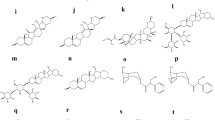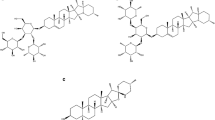Abstract
Aconitum and Colchicum are known to be highly toxic plants based on their respective toxins, namely aconite and colchicine. Aconite and colchicine poisoning generally occurs because of misidentification and contamination, and is also associated with homicide and suicide cases. The detection of aconitines and colchicine in body fluids and leftovers plays an important role in clinical and forensic toxicology investigation of suspected food poisoning by natural poisons. Therefore, we have developed and validated a rapid determination of aconitine, hypaconitine, jesaconitine, mesaconitine, and colchicine in serum, urine, and plants using liquid chromatography–tandem mass spectrometry. All targeted compounds, together with internal standards, were extracted from serum and urine using a C18 monolithic spin column. Recovery of all compounds from serum, spiked at concentrations of 0.1, 0.8, 6, and 18 ng mL−1, ranged from 96.8 to 101.4 %. Recovery of all compounds from urine, spiked at concentrations of 0.1, 8, 80 and 190 ng mL−1, ranged from 96.6 to 101.9 %. The intra- and inter-assay accuracy and precision (expressed as relative standard deviation, %RSD) evaluated for all compounds were within 96.7–103.2 % and 1.7–11.5 %, respectively. Detection limits and quantitation limits of aconitines and colchicine for serum and urine were 0.05 and 0.1 ng mL−1, respectively. This method had a chromatographic run time of 7.0 min. Calibration curves for serum and urine ranged from 0.1 to 20 ng mL−1 for serum and 0.1–200 ng mL−1 for urine, respectively. The validated method was successfully applied to clinical aconitine and colchicine poisoning cases.



Similar content being viewed by others
References
Niitsu H, Fujita Y, Fujita S, Kumagai R, Takamiya M, Aoki Y, Dewa K (2013) Distribution of aconitum alkaloids in autopsy cases of Aconite poisoning. Forensic Sci Int 227:111–117
Pullela R, Young L, Gallagher B, Avis SP, Randell EW (2008) A case of fatal aconitine poisoning by Monkshood ingestion. J Forensic Sci 53:491–494
Ono T, Hayashida M, Uekusa K, Lai CF, Hayakawa H, Nihira M, Ohno Y (2009) An accidental case of aconite poisoning due to Kampo herbal medicine ingestion. Leg Med 11:132–135
Boehm KM, Yum E, Caraccio T (2011) An overdose of aconite by a twenty-six-year-old woman. J Emerg Med 41:298
Chan TY (2009) Aconite poisoning presenting as hypotension and bradycardia. Hum Exp Toxicol 28:795–797
Bao Y, Yang F, Yang X (2011) CE-electrochemiluminescence with ionic liquid for the facile separation and determination of diester-diterpenoid aconitum alkaloids in traditional Chinese herbal medicine. Electrophoresis 32:1515–1521
Liu H, Wen Y, Luan F, Gao Y (2009) Application of experimental design and radial basis function neural network to the separation and determination of active components in traditional Chinese medicines by capillary electrophoresis. Anal Chim Acta 638:88–93
Kang XQ, Fan ZC, Zhang ZQ (2010) Simultaneous determination of three Aconitum alkaloids in six herbal medicines by high-performance liquid chromatography. J Chromatogr Sci 48:860–865
Yang Y, Chen J, Shi YP (2010) Determination of aconitine, hypaconitine and mesaconitine in urine using hollow fiber liquid-phase microextraction combined with high-performance liquid chromatography. J Chromatogr B 878:2811–2816
Sun B, Wu S, Li L, Li H, Zhang Q, Chen H, Li F, Dong F, Yan X (2009) A metabolomic analysis of the toxicity of Aconitum sp. alkaloids in rats using gas chromatography/mass spectrometry. Rapid Commun Mass Spectrom 23:1221–1228
Ito K, Tanaka S, Funayama M, Mizugakai M (2000) Distribution of Aconitum alkaloids in body fluids and tissues in suicidal case of aconite ingestion. J Anal Toxicol 24:348–353
Ka-Wing Chung K, Pak-Lam Chen S, Ng SW, Wing-Lai Mak T, Sze-Yin Leung K (2012) Measurement of yunaconitine and crassicauline A in small-volume blood serum samples by LC–MS/MS: tracing of aconite poisoning in clinical diagnosis. Talanta 97:491–498
Wong SK (2009) Determination of Aconitum alkaloids in dietary supplements and raw botanical materials by liquid chromatography/UV detection with confirmation by liquid chromatography/tandem mass spectrometry: collaborative study. J AOAC Int 92:111–118
Sussman JS, Brozena SC, Skop N, Korecka M, Shaw LM (2004) Accidental intravenous colchicine poisoning. Ther Drug Monit 26:688–692
Finkelstein Y, Aks SE, Hutson JR, Juurlink DN, Nguyen P, Dubnov-Raz G, Pollak U, Koren G, Bentur Y (2010) Colchicine poisoning: the dark side of an ancient drug. Clin Toxicol (Phila) 48:407–414
Milne ST, Meek PD (1998) Fatal colchicine overdose: report of a case and review of the literature. Am J Emerg Med 16:603–608
Kintz P, Jamey C, Tracqui A, Mangin P (1997) Colchicine poisoning: report of a fatal case and presentation of an HPLC procedure for body fluid and tissue analyses. J Anal Toxicol 21:70–72
Deveaux M, Hubert N, Demarly C (2004) Colchicine poisoning: case report of two suicides. Forensic Sci Int 143:219–222
Weakley-Jones B, Gerber JE, Biggs G (2001) Colchicine poisoning: case report of two homicides. Am J Forensic Med Pathol 22:203–206
Seghatoleslami A, Amrollahi-Sharifabadi M, Bayani F, Amrollahi-Sharifabadi M, Mirjalili M (2013) Fatal colchicine poisoning by accidental ingestion of Colchicum persicum: a case report. Am J Forensic Med Pathol 34:295–298
Nagesh KR, Menezes RG, Rastogi P, Naik NR, Rasquinha JM, Senthilkumaran S, Fazil A (2011) Suicidal plant poisoning with Colchicum autumnale. J Forensic Legal Med 18:285–287
Carlier J, Guitton J, Romeuf L, Bévalot F, Boyer B, Fanton L, Gaillard Y (2015) Document Screening approach by ultra-high performance liquid chromatography-tandem mass spectrometry for the blood quantification of thirty-four toxic principles of plant origin. Application to forensic toxicology. J Chromatogr B 975:65–76
Vaclavik L, Krynitsky AJ, Rader JI (2014) Targeted analysis of multiple pharmaceuticals, plant toxins and other secondary metabolites in herbal dietary supplements by ultra-high performance liquid chromatography–quadrupole-orbital ion trap mass spectrometry. Anal Chim Acta 810:45–60
Ng SW, Ching CK, Chan AYW, Mak TWL (2013) Simultaneous detection of 22 toxic plant alkaloids (aconitum alkaloids, solanaceous tropane alkaloids, sophora alkaloids, strychnos alkaloids and colchicine) in human urine and herbal samples using liquid chromatography-tandem mass spectrometry. J Chromatogr B 942–943:63–69
Bourgogne E, Soichot M, Latour C, Laprévote O (2013) Rugged and accurate quantitation of colchicine in human plasma to support colchicine poisoning monitoring by using turbulent-flow LC–MS/MS analysis. Bioanalysis 5:2889–2896
Zhang C, Wu H, Huang X, Zhu Z, Luo H, Huang F, Lin X (2012) Simultaneous determination of toxic alkaloids in blood and urine by HPLC-ESI-MS/MS. Chromatographia 75:499–511
Fujita Y, Teruji K, Fujita M, Kakizawa A, Sato N, Oikawa K, Aoki H, Takahashi K, Endo S (2007) Five cases of aconitine poisoning: toxicokinetics of aconitines. J Anal Toxicol 31:132–137
Ito K, Tanaka S, Konno S, Konishi Y, Mizugaki M (1998) Report on the preparation of deuterium-labeled aconitine and mesaconitine and their application to the analysis of these alkaloids from body fluids as internal standard. J Chromatogr B 714:197–203
Kurasawa K, Ohfusa H, Matsuo H, Matsuzawa K, Kishi E, Matsubayashi K, Maruyama D, Mizugaki M (1993) A case of “Torikabuto” intoxication with documented follow-up measurements of Aconitum alkaloids in the urine. Jpn J Toxicol (Chudoku Kenkyu) 6:185–188 (in Japanese, English abstract)
Acknowledgments
This work was supported in part by a Grant-in-Aid for Scientific Research (C) (No. 25460878) from the Japan Society for the Promotion of Science.
Author information
Authors and Affiliations
Corresponding author
Rights and permissions
About this article
Cite this article
Saito, T., Umebachi, R., Namera, A. et al. Identification and Quantification of Aconitines and Colchicine in Serum, Urine, and Plants using MonoSpin C18 and LC-MSMS. Chromatographia 78, 1041–1048 (2015). https://doi.org/10.1007/s10337-015-2921-z
Received:
Revised:
Accepted:
Published:
Issue Date:
DOI: https://doi.org/10.1007/s10337-015-2921-z




